| Listing 1 - 10 of 26 | << page >> |
Sort by
|

ISBN: 0585070067 0520208447 Year: 1997 Publisher: Berkeley, Calif. : University of California Press,
Abstract | Keywords | Export | Availability | Bookmark
 Loading...
Loading...Choose an application
- Reference Manager
- EndNote
- RefWorks (Direct export to RefWorks)
Regions & Countries - Asia & the Middle East --- History & Archaeology --- East Asia --- Japan --- Social life and customs

ISBN: 0585147442 9780585147444 0890967504 9780890967508 158544054X 9781585440542 Year: 1997 Volume: 53 Publisher: College Station : Texas A&M University Press,
Abstract | Keywords | Export | Availability | Bookmark
 Loading...
Loading...Choose an application
- Reference Manager
- EndNote
- RefWorks (Direct export to RefWorks)
"The 1970-75 war in Cambodia directly involved the United States, contributed to the downfall of an American president, led to the "killing fields," and explains much of what has since happened in Cambodia. Yet, because U.S. involvement in that part of Southeast Asia was largely clandestine, the American people know little about it, regarding the fighting in Cambodia as a small sideshow to the Vietnam War. In fact, it was a full-scale war in which a small nation, sucked into the vortex of Cold War geopolitics, was propelled into one of history's bloodiest, most brutal periods." "This is the first book to deal exclusively with the military aspects of the Cambodian War. In its introductory chapters Wilfred P. Deac describes Cambodia and its people, the decades of French colonialism, and the early years of independence under Prince Sihanouk." "In the balance of the book, Deac describes the events of the five years of warfare: the early American and South Vietnamese incursions and the first Cambodian government offensives; the battle for control of the countryside, lost by the government; the corruption, popular unrest, and political in-fighting that weakened the government; the ascendancy of the Khmer Rouge over their North Vietnamese allies; the nonstop, 189-day American bombing offensive in 1973; the siege, strangulation, and fall of Phnom Penh; and the introduction of the horror of the killing fields. A brief afterword looks at Cambodian postwar policies, the Khmer Rouge-Vietnamese War of 1978-79, and today's prostrate Cambodia, an inevitable result of war."--Jacket.
Southeast Asia --- Regions & Countries - Asia & the Middle East --- History & Archaeology --- Cambodia --- History
Book
ISBN: 2130737196 9782130742890 2130742890 9782130737193 Year: 1997 Publisher: Paris (6, avenue Reille 75685) : P.U.F.,
Abstract | Keywords | Export | Availability | Bookmark
 Loading...
Loading...Choose an application
- Reference Manager
- EndNote
- RefWorks (Direct export to RefWorks)
Dès le milieu du IVe millénaire, on voit se développer en basse Mésopotamie, c'est-à-dire au sud de l'Iraq actuel, un système d'écriture sur argile et sur pierres qui nous renseigne sur l'évolution des sociétés archaïques. Il fut inventé dans ce qu'on appelait alors le pays de Sumer, mais il se répandit peu à peu sous la forme plus abstraite dite « cunéiforme » dans les régions voisines, jusqu'aux extrémités du croissant fertile. Ces documents comportent des tablettes d'argile pour les opérations commerciales ou politiques, ainsi que des bas-reliefs en pierres sculptées. Ils nous révèlent l'histoire des pays de Sumer et d'Akkad, puis l'adoption de cette écriture en Transtigrine et dans les régions méditerranéennes nous permet de connaître toute l'histoire du Proche-Orient antique. On voit se développer sur le Haut Tigre le royaume d'Assour, plus à l'est l'Elam, sur le Moyen Euphrate le pays de Mari, ses voisins méditerranéens, notamment Ugarit, et en Asie mineure le royaume hittite. Tous ces États entrèrent en contact les uns avec les autres pour des motifs économiques et politiques. Au début du IIe millénaire on voit les Assyriens entretenir des relations commerciales avec la région de Kayseri en Asie mineure, mais ce sont les archives de Mari qui fournissent la documentation la plus riche sur tous ces royaumes. L'expansion araméenne s'est étendue jusqu'en Babylonie. Les Assyriens parvinrent à réagir et on les voit entrer en contact avec les Hittites, qui avaient pénétré en Mésopotamie. Il se forme alors quatre grandes zones d'influence, celle de Babylone, d'Assour, des Hittites et des régions méditerranéennes. Il y eut des allées et venues entraînant parfois des conflits, mais aucun État ne cherchait à constituer véritablement un empire. Cette tendance s'est développée par la suite, au Ier millénaire, mais auparavant les différents royaumes établirent des contacts relativement équilibrés. C'est l'évolution de ces événements que présente cet ouvrage. L'immense documentation accumulée au cours de ces dernières années, dont on trouve une liste au début du volume, a nécessité la collaboration de trois spécialistes de ces civilisations. Mais il subsiste de vastes problèmes, dont on trouvera l'exposé dans la deuxième partie de l'ouvrage.
Regions & Countries - Asia & the Middle East --- History & Archaeology --- Middle East --- History
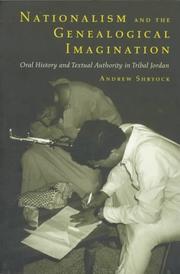
ISBN: 0520201019 0520201000 Year: 1997 Volume: *3 Publisher: Berkeley ; Los Angeles ; London University of California press
Abstract | Keywords | Export | Availability | Bookmark
 Loading...
Loading...Choose an application
- Reference Manager
- EndNote
- RefWorks (Direct export to RefWorks)
Bedouins --- Oral tradition --- Regions & Countries - Asia & the Middle East --- History & Archaeology --- Middle East --- Historiography --- Historiography. --- Jordan --- Genealogy. --- Genealogy

ISBN: 3486550802 3486702076 Year: 1997 Volume: 43 Publisher: München R. Oldenbourg Verlag
Abstract | Keywords | Export | Availability | Bookmark
 Loading...
Loading...Choose an application
- Reference Manager
- EndNote
- RefWorks (Direct export to RefWorks)
";Die deutschen Juden"; - jede andere Art von Titel wäre in diesem Zusammenhang eine Kapitulation vor dem Nationalsozialismus. Die deutschen Juden waren integraler Bestandteil der deutschen Gesellschaft und verstanden sich ihrer Gesinnung und Einstellung nach als Deutsche. Erst die nationalsozialistische Rassengesetzgebung von 1935 hat die deutschen Juden zu ";Juden in Deutschland"; degradiert. Die jüdische Geschichte von 1914 bis 1945 stand schon vor 1933 unter dem Vorzeichen eines Rückgangs oder sogar eines Untergangs des deutschen Judentums - ein Rückgang, der sich auf quantitative Entwicklungen der Gemeinden, das Gemeindeleben und die Beteiligung an Politik und Wirtschaft erstreckte, bevor die Nationalsozialisten die gewaltsame Ausgrenzung, Degradierung und schließlich völlige Vernichtung in Gang setzten. Auch ohne Hitler, so darf man vermuten, hätte die jüdische Bevölkerung, deren Anteil bereits auf weniger als 1% der Gesamtbevölkerung gesunken war, zunehmend an Gewicht, Bedeutung und Eigenart verloren. Paradox ist, dass das Dritte Reich sich in der jüdischen Bevölkerung eine ohnehin im Abnehmen begriffene Gruppe zum ";Feind"; gesetzt und sie in den physischen Untergang im grausamsten Sinne des Wortes geführt hat. Zimmermann wendet sich mit seiner Art der Darstellung gegen die ";Ghettoisierung"; der jüdischen Geschichte. Im Unterschied zur verbreiteten Haltung, diese Geschichte isoliert zu betrachten, verfolgt er die Wechselbeziehungen zwischen Juden und Nicht-Juden als Segmente ein- und derselben Gesellschaft.
Jews --- History --- Germany --- Weimar Republic, Germany, 1918-1933 --- Persecutions --- Middle East --- Regions & Countries - Europe --- Regions & Countries - Asia & the Middle East --- History & Archaeology
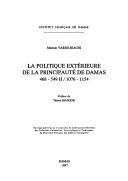
ISBN: 2901315356 2351594916 9782901315353 Year: 1997 Volume: 163 Publisher: Damas: Institut français de Damas,
Abstract | Keywords | Export | Availability | Bookmark
 Loading...
Loading...Choose an application
- Reference Manager
- EndNote
- RefWorks (Direct export to RefWorks)
L'analyse des sources arabes, manuscrites comme éditées, permet de reconstituer l'histoire de la principauté de Damas, de 1076 (date de sa constitution au départ des troupes fatimides qui occupaient la ville) jusqu'en 1154 (prise de la cite par le prince zankide Nur al-Din et, ainsi, formation d'un grand État de Syrie et Gazira). Cette étude s'attache a suivre la politique extérieure des maitres successifs de Damas, face aux Fatimides, aux Salguqides, puis aux Francs et petites principautés.
Damascus (Syria) --- Syria --- Islamic Empire --- History --- Regions & Countries - Asia & the Middle East --- History & Archaeology --- Middle East --- -Islamic Empire --- -Syria --- Arab countries --- Arab Empire --- Empire, Islamic --- Muslim Empire --- -History --- -Regions & Countries - Asia & the Middle East --- History. --- Damascus (Syria) - History --- Syria - History - 750-1260 --- Islamic Empire - History - 750-1258 --- politique extérieure --- Syrie --- Jihad --- Damas --- guerre --- Fatimides
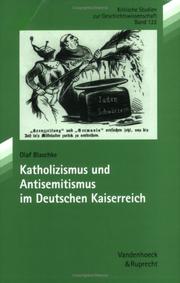
ISBN: 3525357850 3666357857 Year: 1997 Publisher: Göttingen Vandenhoeck und Ruprecht
Abstract | Keywords | Export | Availability | Bookmark
 Loading...
Loading...Choose an application
- Reference Manager
- EndNote
- RefWorks (Direct export to RefWorks)
Antisemitism --- -Antisemitism --- -Catholics --- -Christians --- Anti-Jewish attitudes --- Anti-Semitism --- Ethnic relations --- Prejudices --- Philosemitism --- History --- -History --- -Germany --- Ethnic relations. --- Catholics --- Christians --- Germany --- Middle East --- Regions & Countries - Asia & the Middle East --- History & Archaeology
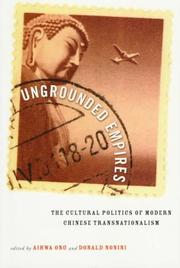
ISBN: 0415915430 0415915422 0203443292 0203426665 1280074795 1135964203 9780203426661 9780415915427 9786610074792 6610074798 9780415915434 9780203426661 9781135964207 9781135964153 1135964157 9781135964191 113596419X 9781280074790 0005915422 9780005915424 Year: 1997 Publisher: New York : Routledge,
Abstract | Keywords | Export | Availability | Bookmark
 Loading...
Loading...Choose an application
- Reference Manager
- EndNote
- RefWorks (Direct export to RefWorks)
This book examines Chinese transnationalism as a distinctive domain within the new 'flexible' capitalism emerging in the Asia-Pacific region. It is based on new ethnographic research and interweaves anthropology, culture and politics.
Chinese --- Nationalism --- Chinois à l'étranger --- Nationalisme --- Ethnic identity --- Economic conditions --- Identité ethnique --- Conditions économiques --- China --- Chine --- Civilization. --- Civilisation --- East Asia --- Regions & Countries - Asia & the Middle East --- History & Archaeology --- S02/0200 --- S11/1100 --- China: General works--Civilization and culture --- China: Social sciences--Immigration and emigration, Overseas Chinese (huaqiao) --- Economic conditions. --- Ethnic identity. --- Chinois à l'étranger --- Identité ethnique --- Conditions économiques --- Ethnology
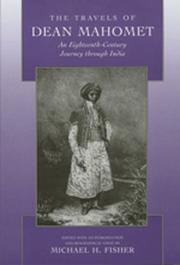
ISBN: 0520207165 0520207173 0520918517 0585131120 9780520918511 9780585131122 9780520207165 9780520207172 Year: 1997 Publisher: Berkeley : University of California Press,
Abstract | Keywords | Export | Availability | Bookmark
 Loading...
Loading...Choose an application
- Reference Manager
- EndNote
- RefWorks (Direct export to RefWorks)
This unusual study combines two books in one: the 1794 autobiographical travel narrative of an Indian, Dean Mahomet, recalling his years as camp-follower, servant, and subaltern officer in the East India Company's army (1769 to 1784); and Michael H. Fisher's portrayal of Mahomet's sojourn as an insider/outsider in India, Ireland, and England. Emigrating to Britain and living there for over half a century, Mahomet started what was probably the first Indian restaurant in England and then enjoyed a distinguished career as a practitioner of "oriental" medicine, i.e., therapeutic massage and herbal steam bath, in London and the seaside resort of Brighton. This is a fascinating account of life in late eighteenth-century India--the first book written in English by an Indian--framed by a mini-biography of a remarkably versatile entrepreneur. Travels presents an Indian's view of the British conquest of India and conveys the vital role taken by Indians in the colonial process, especially as they negotiated relations with Britons both in the colonial periphery and the imperial metropole. Connoisseurs of unusual travel narratives, historians of England, Ireland, and British India, as well as literary scholars of autobiography and colonial discourse will find much in this book. But it also offers an engaging biography of a resourceful, multidimensional individual.
Immigrants --- East Indians --- South Asia --- Regions & Countries - Asia & the Middle East --- History & Archaeology --- History --- Social conditions --- Asian Indians --- Indians, East --- Indic peoples --- Ethnology --- Emigrants --- Foreign-born population --- Foreign population --- Foreigners --- Migrants --- Persons --- Aliens --- Indians (India) --- Social conditions. --- Mahomet, Sake Deen, --- Travel --- East India Company. --- India --- Politics and government --- Mahomed, Sake Deen, --- Dean Mahomet, --- Himself, --- Mahomet, Dean, --- Mahomed, Dean, --- Dean Mahomed, --- India.
Book
ISBN: 2905838361 2821821565 2905838647 Year: 1997 Publisher: CEDEJ - Égypte/Soudan
Abstract | Keywords | Export | Availability | Bookmark
 Loading...
Loading...Choose an application
- Reference Manager
- EndNote
- RefWorks (Direct export to RefWorks)
Palestinian Arabs --- Businessmen --- Businessmen, Palestinian Arab --- Regions & Countries - Asia & the Middle East --- History & Archaeology --- Middle East --- Ethnic identity. --- Palestinian Arab businessmen --- Business men --- Arab Palestinians --- Arabs --- Arabs in Palestine --- Palestinians --- Businesspeople --- Ethnology --- Syrie --- Égypte --- diaspora palestinienne --- Organisation de libération de la Palestine (OLP) --- Palestine
| Listing 1 - 10 of 26 | << page >> |
Sort by
|

 Search
Search Feedback
Feedback About UniCat
About UniCat  Help
Help News
News